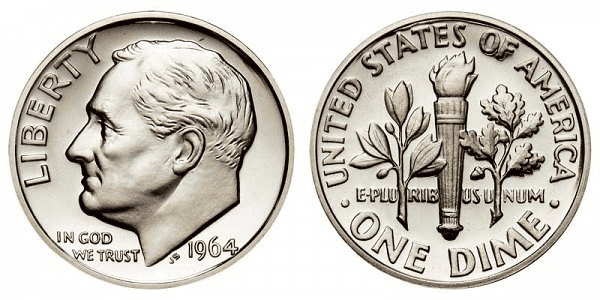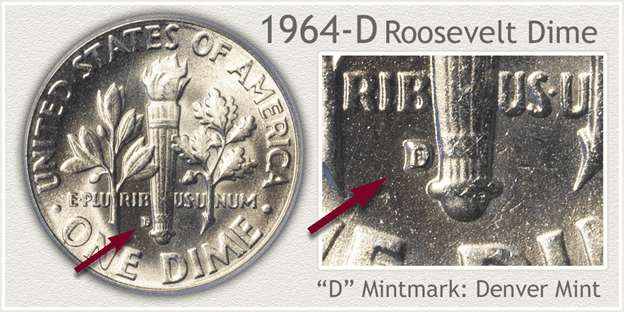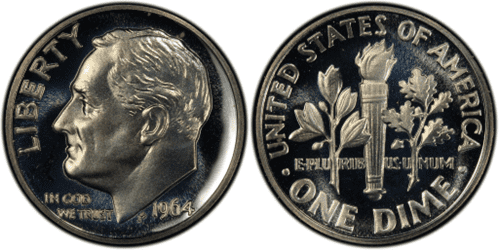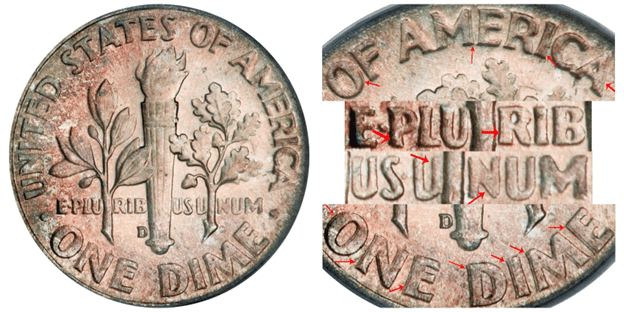What Is The 1964 Roosevelt Dime?
1964 was an important year in the coin minting industry as it was the last year that many coins were struck with a silver composition, which changed in the following year to nickel and copper due to soaring silver prices.
Featuring well-regarded president Franklin D. Roosevelt (FDR), the Roosevelt Dime has a composition of 90% (0.999) silver with added 10% copper, this comprises a silver weight of 0.07234 troy ounces (2.25 g), with the overall coin weighing around 2.5g or 0.08038 troy ounces.
With a face value of 10 cents, the Roosevelt dime has a diameter of 17.91mm, and a thickness of 1.35mm. It has a typical round shape and features reeded edges. John R. Sinnock designed the obverse and reverse designs, which are still in use today.
On the obverse, Roosevelt’s picture faces left and is surrounded by the words “Liberty” and “In God We Trust.” On the reverse, a torch is flanked on the left by an olive branch and on the right by an oak branch. Peace and power are represented by these branches.
One of the biggest milestones of 1964 was the Tokyo Olympics where a vast majority of medals were won by the US team. Dr Martin Luther King received the Nobel Peace Prize for the year, and the Beatles released their first album in the USA, starting off Beatlemania on a new continent.
Is A 1964 Dime All Silver?
All silver dimes, quarters, and half dollars issued in the United States before 1964 contain 90% silver, so if you have a coin dated on or before this year, your coin is almost certainly silver. However, to make sure you can undertake a simple step.
The best way to tell if your coins are silver is to look at their edges. You can be certain that the coin is silver if it has a solid silver stripe. If a copper stripe can be seen, the coin is clad.
1964 Dime Series
1964 Dime With No Mint Mark
Year: 1964
Face Value: $0.10
Composition: 90% silver and 10% copper
Total Weight: 2.5g
Diameter: 17.91mm
Thickness: 1.35mm
Edge: 115 Reeds
Minted in: Philadelphia
Quantity Minted: 929,360,000

photo source: www.usacoinbook.com
1964 D Dime
Year: 1964
Face Value: $0.10
Composition: 90% silver and 10% copper
Total Weight: 2.5g
Diameter: 17.91mm
Thickness: 1.35mm
Edge: 115 Reeds
Minted in: Denver
Quantity Minted: 1,357,517,180

photo source: www.coinstudy.com
1964 Proof
Year: 1964
Face Value: $0.10
Composition: 90% silver and 10% copper
Total Weight: 2.5g
Diameter: 17.91mm
Thickness: 1.35mm
Edge: 115 Reeds
Minted in: Philadelphia
Quantity Minted: 3,950,762

photo source: www.pcgs.com
List of Errors
Doubled Die Reverse
Some of the 1964 D Silver Roosevelt Dime coins had a severe flaw. On the reverse of some coins, the words “UNITED STATES OF AMERICA” – “ONE DIME” and the motto “E PLURIBUS UNUM” are somewhat doubled.
The word “ONE DIME” has the most apparent and noticeable doubling, as shown by the arrows above.
The phrases “UNITED STATES OF AMERICA” have a noticeable doubling throughout, but especially in the words “OF AMERICA” as represented.
The doubling in the motto “E PLURIBUS UNUM” is far more difficult to notice. Look for slightly bigger letters and very tiny doubling on a few of the characters, particularly in the letter “N” in “UNUM.”
The value of this error coin depends on the condition and visual appearance and can range from $6-170.
Other Errors
While not common, the following coin error types have been seen in the 1964 Dime.
- Clipped Planchet: A missing part on clipped planchet dimes is caused by a misfeed during the minting process (often elliptical-shaped). On a good day, clipped planchet dimes in Mint State condition can pay $30!
- Blank Planchet: These one-of-a-kind dimes make their way out of the mint without ever being struck with a design. These dime errors, which are blank on both sides, usually have a value of only a few bucks.
- Off Center Strike: An off-centre strike coin has an obverse or reverse image that was not properly aligned during the striking process. These coins are frequently deformed and have blank planchet sections. The value of the coin varies depending on the degree of the off-centre striking, however, it can range from $10 to $20 per coin.
What Is The Value Of A 1964 Dime?
1964 Dimes have conditional value, meaning that in order to rise about its melt value, there needs to be something exceptional about the coin such as condition or error type. With so many available, a well-preserved 1964 dime can command a premium over base silver value.
Grades are names that describe the various states that can be found on coins. The majority of coins have been worn to varying degrees. Fewer are in mint condition, which is characterized as having no wear on the surface.
With a silver weight of 2.25g, the melt value of the 1964 dime far exceeds its face value which currently sits at approximately $2.89.
1964 Dime Values Chart
| Coin | Mintage | Value (Dependent on Grade) |
| 1964 No Mintmark (Philadelphia) | 929,360,000 | £3 + |
| 1964-D (Denver) | 1,357,517,180 | $3 + |
| 1964 Proof | 3,950,762 | $4 + |
How Does The Grading System Work?
The Sheldon Scale is used by numismatists to provide a numerical value to coins. The Sheldon Scale goes from poor (P-1) to perfect mint state (P-1) (MS-70). Coins were originally evaluated using words to reflect their condition (Good, Fair, Excellent, Etc.). Unfortunately, coin collectors and dealers had different ideas about what each of these terms represent.
Professional numismatists joined together in the 1970s and established CoinGrading standards. These numismatists now assign grades at key places on the seventy-point scale, using the most regularly utilized numeric points in conjunction with the original adjective grade. The following are the most common coin grades:
-
-
- (P-1) Poor – Indistinguishable and probably damaged; if used, must have a date and mintmark; otherwise, rather battered.
- (FR-2) Fair – Nearly smooth, but without the damage that a coin graded Poor often possesses. The coin must have enough detail to be identified.
- (G-4) Fair – Inscriptions have merged into the rims in some areas, and important elements have been mostly erased.
- (VG-8) Very Good- A little weathered, but all of the primary design elements are visible, albeit faintly. There is little if any, central detail left.
- (F-12) Good – The item is very worn, yet the wear is even, and the overall design details stand out clearly. Rims are almost completely isolated from the field.
- (VF-20) Very Fine – Moderately weathered, with some finer features still visible. The motto or all letters of LIBERTY are readable. Both sides of the coin have entire rims that are separated from the field.
- (EF-40) Extremely Fine – Gently used; all gadgets are visible, and the most important ones are bold. The finer details are bold and clear, however, light wear may be seen.
- (AU-50) Uncirculated – Slight evidence of wear on the coin’s design’s high points; may have contact marks; eye appeal should be adequate.
- (AU-58) Uncirculated Choice – Slight traces of wear, no severe contact marks, almost full mint shine, and great eye appeal.
- (MS-60) Mint State Basal – Strictly uncirculated; no indication of wear on the coin’s highest points, but an unsightly coin with reduced luster, visible contact marks, hairlines, and other flaws.
- (MS-63) Mint State Acceptable – Uncirculated, but with contact scratches and nicks, little reduced shine, but otherwise appealing appearance. The strike is weak to average.
- (MS-65) Mint State Choice – Uncirculated with great mint shine, very little contact blemishes, and exceptional eye appeal. The strike is unusually severe.
- (MS-68) Mint State Premium Quality – Uncirculated with superb luster, no obvious contact marks to the naked eye, and exceptional eye appeal. The strike is quick and appealing.
- (MS-69) Almost Perfect Mint State – Uncirculated with perfect brilliance, a sharp and appealing strike, and extremely good eye appeal. A near-perfect coin with minor imperfections in the planchet, strike, and contact markings (seen only under 8x magnification).
- (MS-70) Mint State Perfect – Under 8x magnification, there are no tiny imperfections discernible; the strike is crisp, and the coin is perfectly centered on a beautiful planchet. Rarely seen on a coin, this coin is bright and whole, with original luster and exceptional eye appeal.
-
What Makes A 1964 Dime Rare?
The 1964 dime really isn’t one of the rarest coins out there, and a few pop up in regular circulation every now and again, making for a nice find as a near $3 melt value is a nice profit on a coin with a 10c face value.
As already alluded to, the rare 1964 Dimes are those in exceptional condition, as evidenced by the $1 starting price increase on proof coins due to the quality of the casting.
The most valuable error coin example is the doubled die error, at up to $170, but there really aren’t any stand out ‘be on the lookout’ 1964 Dimes out there.
Where To Buy Or Sell 1964 Dimes?
Due to their high silver content, 1964 dimes can be bought and sold through silver dealers and pawnbrokers, and if you built up a nice collection over time, this could achieve you a pretty penny.
Mostly 1964 Dimes are sought after by beginner collectors and those who appreciate the sentimental value of the mintage year. Because of this, online marketplace such as eBay and Etsy makes a good choice for buying and selling 1964 dimes.
There’s also some interest in silver-heavy coins as a nest egg, with people purchasing when the value of silver is low, hoping to sell on when prices improve. Therefore, buying 1964 dimes in multiples is also possible, as seen in the eBay and Etsy listings linked above.
More valuable Roosevelt dimes such as error examples can be bought and sold at specialist sites such as Vcoins.
FAQs
Where is the mint mark on a 1964 dime?
The mint mark of the 1964 dime can be found to the left of the torch on the reverse side of the coin. Of course, remember that coins minted in Philadelphia are without a mint mark.
Are Roosevelt dimes valuable?
Aside from a few specific examples, Roosevelt dimes don’t hold much value outside of their melt value.
How many ounces of silver is in a 1964 dime?
1964 dimes have 0.07234 troy ounces (2.25 g) of silver, which is the main component of their mint value.
Are dimes after 1964 worth anything?
Dimes made after 1964 don’t really have a mint value, which means all value the coin possesses comes from its conditional value such as grade or unique features.




